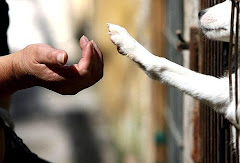 This female rhino was stripped of her horn and killed by poachers in Kaziranga National January 19, 2009. (Photo credit unknown)
This female rhino was stripped of her horn and killed by poachers in Kaziranga National January 19, 2009. (Photo credit unknown)GENEVA, Switzerland, July 16, 2009 (ENS) – Driven by Asian demand for rhinoceros horns, worldwide poaching of these endangered animals is at a 15-year high, new conservation research reveals.
In South Africa and Zimbabwe alone, at least 162 rhinos were illegally killed in 2008 and another 62 have been poached during the first six months of 2009 conservationists told the Standing Committee of the Convention on International Trade in Endangered Species at a meeting last week in Geneva.
The International Union for the Conservation of Nature, IUCN, and the global conservation organization WWF, and their affiliated wildlife trade monitoring network TRAFFIC told the committee that poachers in Africa and Asia are killing as many as two to three animals a week in some areas to meet a growing demand for horns, which are reputed to have medicinal value. Rhino horn is composed of compressed keratin fiber similar to hair.
By contrast, during the first five years of this decade, only three rhinos were illegally killed each month in all of Africa, out of a population of around 18,000, the conservationists estimated.
"Rhinos are in a desperate situation," says Dr. Susan Lieberman, director of the Species Programme, WWF-International. "This is the worst rhino poaching we have seen in many years and it is critical for governments to stand up and take action to stop this deadly threat to rhinos worldwide.""It is time to crack down on organized criminal elements responsible for this trade, and to vastly increase assistance to range countries in their enforcement efforts," Lieberman said.
The conservationists commend South Africa's law enforcement officials for their "focused and innovative attention to this serious conservation challenge," and note a new moratorium on internal rhino horn sales, and a strengthened control framework for the country's sport hunting policy for white rhinoceros, including limiting each hunter to only one rhino a year.
Yet rhino poaching is on the increase in South Africa and poachers are getting bolder. "In June 2009, an armed robbery occurred at a government store within Addo National Park, indicating a further escalation in tactics and modus operandi of illegal horn traders, according to the briefing document.
"Illegal rhino horn trade to destinations in Asia is driving the killing, with growing evidence of involvement of Vietnamese, Chinese and Thai nationals in the illegal procurement and transport of rhino horn out of Africa," the briefing states.
"Local media in South Africa have presented filmed evidence of the complicity of staff of the Viet Nam Embassy in South Africa in the procurement of illegal rhinoceros horns," says the briefing paper.
"Viet Nam was not a major destination for illegal commerce in rhinoceros horn until about five years ago," states the briefing. "In that country, ongoing research is uncovering evidence that rhinoceros horns are currently being promoted for medical uses that greatly expand the scope of rhinoceros horn usage as described in the traditional literature, including using the substance to now treat a range of life threatening illnesses, particularly cancers."
Almost all rhino species are listed in the Convention on Trade in Endangered Species Appendix I, which means that any international trade of any rhino parts for commercial purposes is illegal.
Rhino poaching is a thriving business in Asia. About 10 rhinos have been poached in India and at least seven in Nepal since January, out of a combined population of only 2,400 endangered rhinos, TRAFFIC reports.But one high-profile killing this year shocked the Indian public and sparked a protest against the government of Assam state. On January 19, in Kaziranga National Park, a UNESCO World Heritage Site on the south bank of River Brahmaputra, poachers gouged out the horn of an injured female rhino and killed her three-year-old calf. The poachers first fired upon the female rhino to immobilize her before taking the horn. The injured rhino died the next day. This picture of the dying female rhino appeared in newspapers and on TV, touching off an unprecedented public protest against the government's apathy.
"Funds have been provided by TRAFFIC-India to help the government in Assam deal with the issue of rhinoceros poaching," according to the briefing document, which adds, "These funds have been used to support anti-poaching activities, undertake trade monitoring, establish informant networks, and conduct seizures."
"These efforts have resulted in numerous arrests by government authorities, including seizures of rhinoceros horns, ivory, leopard skins, and weapons."
The conservation groups say more funding is needed for anti-poaching efforts in both Africa and Asia. They are also calling on Chinese enforcement authorities to cooperate with range States, as one of the known trade routes for rhinoceros horn is through Tibet.
Steven Broad, executive director of TRAFFIC, said, "Increased demand for rhino horn, alongside a lack of law enforcement, a low level of prosecutions for poachers who are actually arrested and increasingly daring attempts by poachers and thieves to obtain the horn is proving to be too much for rhinos and some populations are seriously declining."
The situation is particularly dire in Zimbabwe where such problems are threatening the success of more than a decade's work of bringing rhino populations back to healthy levels.
Earlier this month, a park ranger charged with having killed three rhinos in Zimbabwe's Chipinge Safari Area, was acquitted without any satisfactory explanation for the verdict, according to the three conservation groups who say there was "overwhelming evidence against him."
In September 2008, a gang of four Zimbabwean poachers who admitted to killing 18 rhinos were freed in a failed judiciary process.
The briefing concludes that governments need "an accurate and up-to-date picture of the status, conservation and trade in African and Asian rhinoceroses, as well as the factors driving the consumption of rhinoceros horn, so that firm international action can be taken to arrest this immediate threat to rhinoceros populations worldwide."
Dr. Jane Smart, director of IUCN's Biodiversity Conservation Group, says, "IUCN and its African and Asian Rhino Specialist Groups are working hard to gather data and information on rhinos so that CITES parties can make the right decisions and ensure that rhinos are still here for generations to come."
A decision made by CITES Parties at the last triennial meeting in 2007 calls upon all African and Asian rhinoceros range States and Parties that have stocks of rhinoceros horns or their derivatives to declare the status of their stocks before the next CITES meeting in March 2010.
To date, only five Parties - China, Germany, Japan, New Zealand and the United Kingdom - have submitted rhinoceros horn stock declarations to the CITES Secretariat for transmission to TRAFFIC. No rhinoceros range States in either Africa or Asia have yet complied with this decision.
The issue of rhinoceros poaching and survival will be further discussed at the 15th meeting of the Conference of the Parties to CITES, which will be held in Doha, Qatar March 13-25, 2010.
Copyright Environment News Service, ENS, 2009. All rights reserved.
















No hay comentarios:
Publicar un comentario